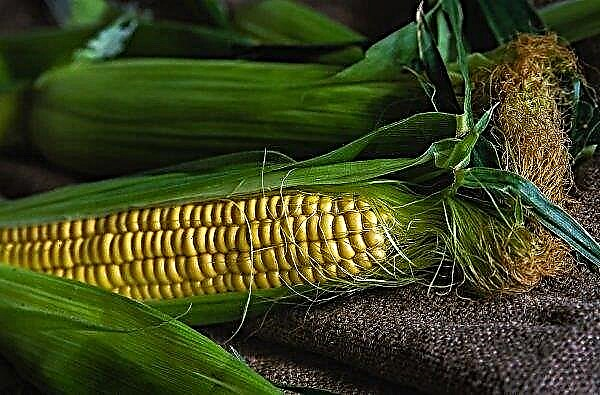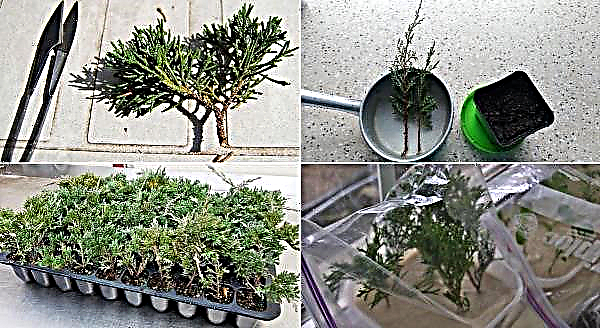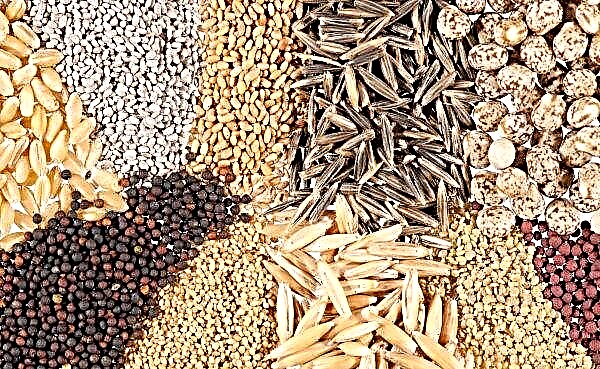Among the many varieties of roses stands out tea-hybrid variety called Osiria, thanks to an unusually attractive color of flowers. You will learn about how to grow beautiful rose bushes in your flowerbed from our article.
Botanical description of the plant
This variety was created by breeders from Germany in 1978. The rose is quite large - up to 1.1 m in height. The bush is 70–80 cm wide. The shoots are straight and slightly articulated. The leaves are large, matte. The buds are long, pointed at the end. The flowers are large (12–16 cm in diameter), terry inside and with a pleasant aroma.
The inner petals are dark red, the outside is milky, with pink edges. The bush blooms from mid-June until the last autumn warmth.
Did you know? Breeders of Japan have created an unusual variety of roses - a chameleon. During the day, the flower is bright red, and closer to night it becomes snow-white.
Planting seedlings in the open ground
Proper landing is the key to the successful development of Osiria. Consider how to properly implement it.
The timing
In order for the rose to develop well, it must be planted in a certain time frame. The most suitable time for this is the beginning of May. By this period, the soil warms up sufficiently under the influence of sunlight. Its temperature should not be lower than + 12 ° C. If you plant a seedling earlier, in cold soil, it will not take root.
Seat selection
Choose a place protected from the wind for Osiria. Direct sunlight should not fall on the area where the bush will grow, while the place should be well lit.
Pay attention to the soil in which you are going to plant the seedling. Rosa loves slightly acid loose soil. It is in it that the bush will grow rapidly and delight you with abundant flowering.
Scheme and Depth
Seedlings are planted at a distance of half a meter from each other. After landing, they are spudded to a height of 15 cm.
Important! Before planting, place the roots of Osiria for 5–7 hours in a container of water so that they absorb enough moisture for them.
For planting, a hole is dug up to a width of 40 cm and a depth of 10-15 cm more than the length of the roots of the seedling. Manure is put at the bottom and it is dug up with the ground. A seedling is placed in the pit, spreading its roots, and sprinkled with soil, tamping and forming a hole around the rose. After this, the seedling must be watered.
The next day, the soil must be loosened.
Care Tips
Rosa Osiria is very demanding in care. But if you make the maximum amount of effort to care for it, the bush will delight you with abundant and long flowering.
Watering
For this rose, timely and proper watering is very important. If there is too much or too little moisture, the bush begins to hurt and may die as a result. A lack of water affects the quality of the flowers. They become small, lose their former color and aroma.
On a hot summer, Osiria is watered once a week. In spring and autumn, it is enough to water it once every ten days. So that the soil does not overheat and does not dry out, after each watering, mulching is carried out using humus.
Top dressing
Fertilize bushes 3-4 times per season with a break of two weeks. Fertilize plants for the first time in early June, and the last time in early August.
Feeding should include phosphorus, potassium and magnesium. It is better to use ready-made complex fertilizers designed specifically for roses, according to the instructions on the packaging. Fertilizers such as Bud Plus, Zircon, and Agricola-Aqua have proven themselves well.
Loosening and weeding
Loosening the soil is carried out the day after each watering of the rose. Due to this procedure, a sufficient amount of fresh air enters the roots. If weeds begin to appear around the bush, they must be removed.
Pruning
The bush is recommended to be pruned throughout the growing season. This increases its growth and promotes re-flowering. Spring pruning is carried out after the full opening of the bush after winter.
In summer, you need to cut the shoots with buds that have bloomed, so that 3-4 leaves are left on the branch. This contributes to the rapid growth of Osiria and the beginning of the second flowering wave. The last time they cut a rose before wintering, at the end of October.
Important! In order for the bush to form a strong root system, do not let it bloom in the first year. Remove all buds until August. During the second flowering wave, leave no more than two flowers.
Shelter for the winter
As soon as the air temperature drops to + 8 ° C, the rose is sheltered for the winter. To do this, sand is poured around the bush to a height of 30 cm or covered with branches of conifers to the same height.
Rosa Osiriya is very demanding in care, but if all the rules for growing it are strictly followed, she will reward your efforts with abundant flowering and wonderful aroma.












